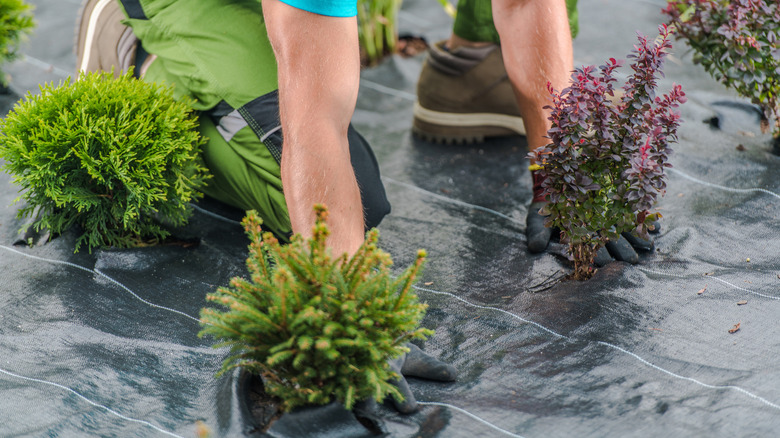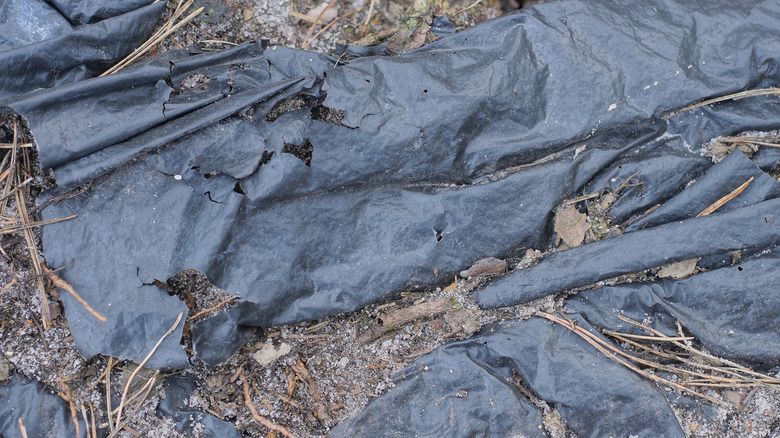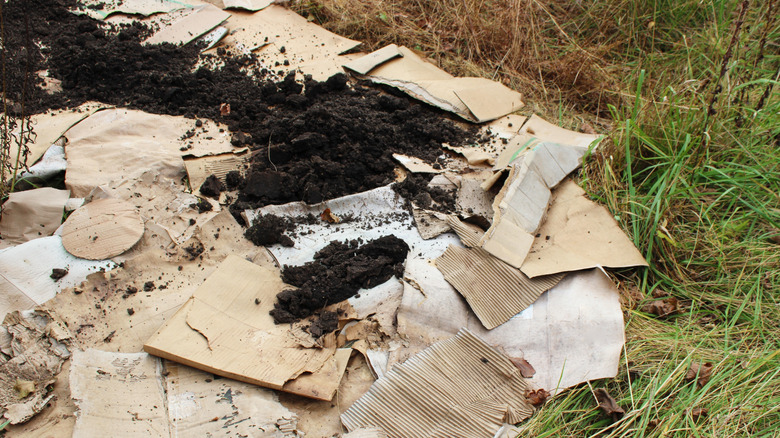Downsides To Using Landscape Fabric That Will Have You Second-Guessing Your Investment
Landscape fabric is often sold as a permanent solution to your weed problem. Professional landscapers and home gardeners alike are accustomed to laying it down underneath a mulch layer to create a tidy, weed-free garden bed. The woven plastic fabric is usually said to be permeable enough that water can still reach the roots of the shrubs or flowers you planted in the fabric-covered area, but solid enough to block weed seedlings from growing through it. And it works — for a year or two.
In the meantime, new weed seeds blown in on the wind will start growing on top of it, and, as the plastic fiber starts to degrade, weed seeds stored underneath will be able to grow through it. At this point, you'll not only be pulling weeds again but also the brittle bits of degraded landscape fabric you laid out a year or so ago.
If you're considering using landscape fabric, it's likely because you're looking for a permanent solution to keep weeds out of a flower bed or a gravel path. Unfortunately, weeds are tenacious so there isn't really a permanent way to completely get rid of them. With that said, there are other methods out there, like sheet mulching or just using eco-friendly mulch options alone, that work as well or better than landscape fabric without creating the problems that the plastic weed barrier causes. So, before laying landscape fabric under gravel pathways or mulch, it's important to understand the downsides of using it and explore alternatives that might be a better fit for your garden.
Landscape fabric is a temporary fix with tons of downsides
When first laid down, landscape fabric does what it claims. It smothers weeds while still allowing air and water through. However, after the first year, the pores will become clogged with sediment. Soil and other organic matter will accumulate on top. The fabric itself will begin to degrade from exposure to the soil, fluctuating temperatures, or light. If you cut holes in it for planting plugs, that will speed up the breakdown of the fabric.
By next year, in the areas where the fabric is still intact, the now-clogged pores can end up depriving the roots and soil below of water and oxygen. Even with proper irrigation or heavy rain, the roots underneath might not be getting enough water to survive. At the same time, the soil can become sterile and compacted from the lack of air and water as well as the lack of new organic matter. Mixing in compost, fertilizer, or other soil amendments is difficult with the plastic barrier in place.
In the areas where the fabric has degraded, weed seeds in the soil below will be able to germinate and grow through the fabric. Meanwhile, the organic matter on top will become the perfect bed for wind-blown weed seeds to germinate. As those weed roots get tangled in the fabric, it'll become harder to pull both the weeds and the fabric itself out of your bed.
What to use instead of landscape fabric
There are plenty of weed barrier alternatives to landscaping fabric that you can try in your garden. If you're preparing a new garden bed, consider sheet mulching. This involves laying cardboard or newspaper and topping it with compost and organic mulch. The cardboard will smother weeds just like a freshly laid piece of landscape fabric. Instead of breaking down into hard-to-remove plastic bits, the cardboard will decompose and combine with the compost and mulch to create a fertile bed of soil.
If you're topping up an existing garden bed with new mulch, just skip the fabric. A 3 or 4 inch layer of any mulch by itself is enough to control most weeds while also regulating soil temperature and moisture. An organic mulch like wood chips or leaves will also feed the soil as it decomposes.
For a gravel path, there's usually no need for landscape fabric. Even if you use it, you still need to periodically replenish your gravel as it sinks into the soil and pull weeds that grow in the gravel. Instead of laying down a plastic barrier that will stop working in a few years, just prepare the area properly. After digging the path, tamp down the soil and add a layer of sand or fine gravel beneath the larger gravel. Tamp down each layer so everything is tightly compacted for a stabilized path. You'll still need to weed and replenish, but you won't ever need to pull up brittle bits of plastic.


